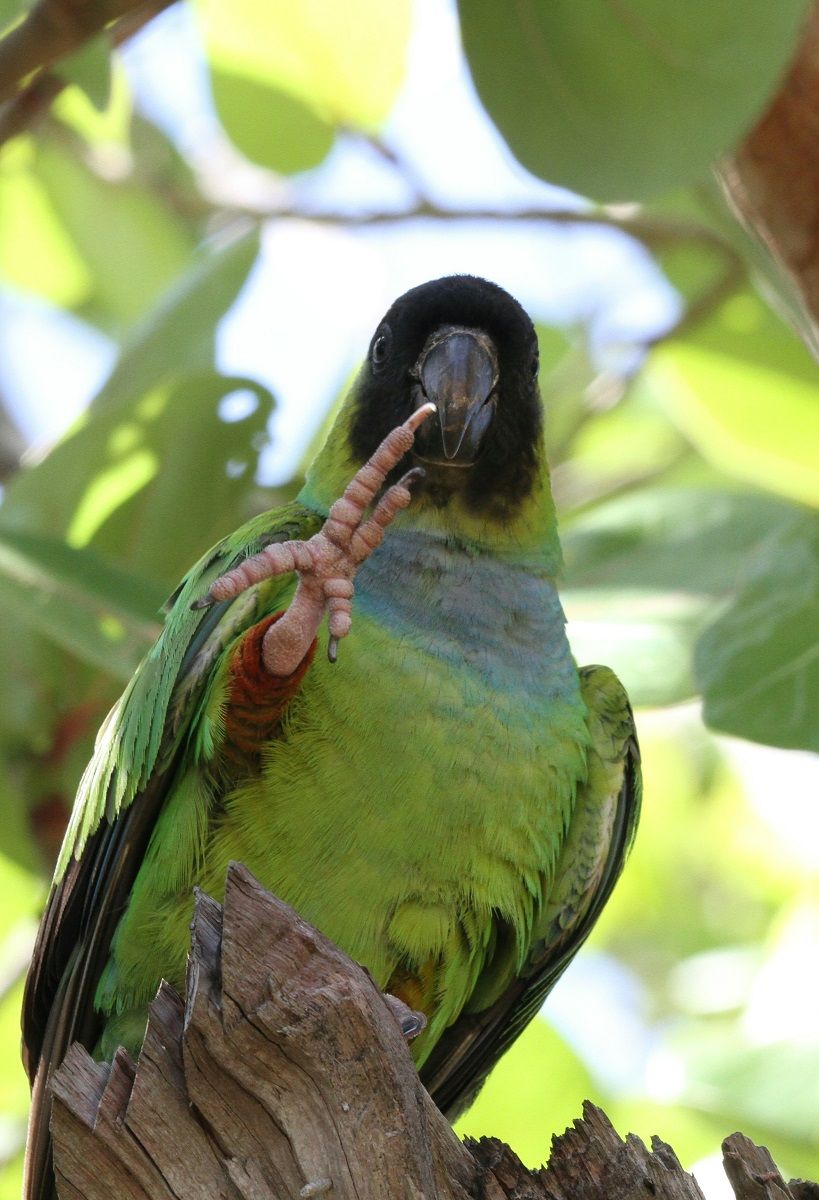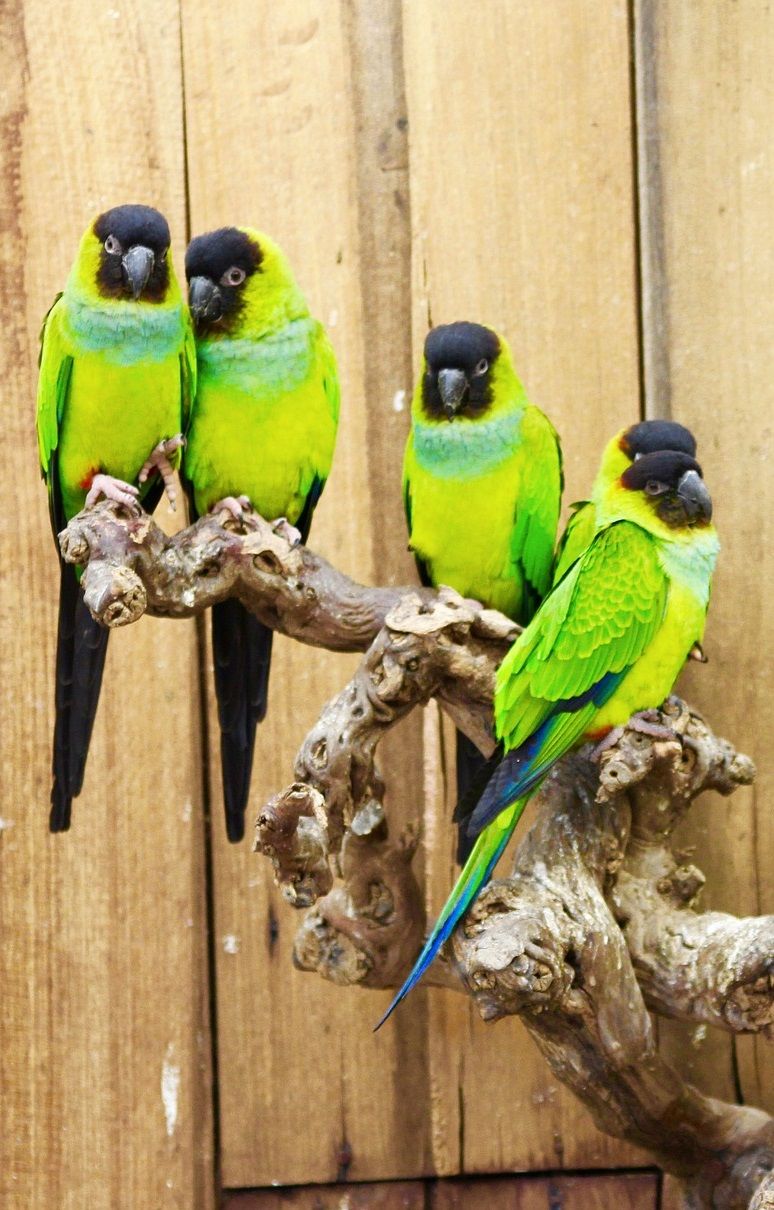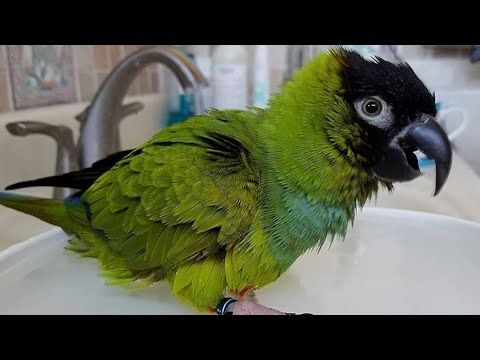Thinking about adding a nanday conure to your family? These friendly and playful South American parrots can make great pets—but only for people with a very high tolerance for noise.
Below, find everything you need to know about your new feathered pet. Where are nanday conures from, what do they eat, and what do they need to thrive?
| Name(s) (common, scientific) | Nanday conure, black-hooded conure, Aratinga nenday (formerly Nandayus nenday*) |
| Natural habitat | Open lowlands in central South America |
| Adult size | Up to 12″ (30 cm) in length, up to 140 grams |
| Lifespan | Up to 30 years |
| Noise level | High |
Nanday conure appearance
The nanday conure is also commonly referred to as the black-hooded conure, and it’s not difficult to see why. That stark black face on an almost entirely bright green body is quite eye-catching!
This species is considered small to medium-sized as far as parrots go. Aside from its striking black hood (surrounded by a few brown feathers), it sports a black beak, white eye rings, blue-green chest feathers, and bright red thighs.
Did you know? Nanday conures can live for up to 30 years with the right care. You can read more in the full post on nanday conure lifespan.

Nanday conure range & natural habitat
This conure is naturally found in central South America. Its range forms a narrow band that stretches right through the center of Paraguay and into southern Brazil and eastern Bolivia, as well as northern Argentina.
In its natural range, the nanday conure is common in former forests turned into cattle pastures. The species likes open lowlands (up to around 2,600ft/800m), which are usually dotted with palms (which they use for nesting) and can be swampy to quite dry.
The IUCN Red List considers Aratinga nenday (spelled with an “E”, as opposed to the “A” in the common name) to be a species of Least Concern. It notes the wild population size actually appears to be increasing thanks to habitat changes as a result of human activity.
Did you know? Like many other parrots, the nanday conure is an invasive species in some countries. Released pets have managed to survive and reproduce, leading to flocks thriving in places like Spain, California, Florida, and more (it’s in the top 3 in the US!). This can negatively affect local ecosystems.

Nanday conure diet
Wild diet
Nanday conures in their natural habitat mostly eat wild fruits, such as those of the Copernicia palm. They also consume seeds and berries, as well as flowers and flower buds. A pretty varied diet!
According to a 2002 study, the nenday conure is a pollinator for the beautiful flowering Erythrina dominguezii tree. It drinks nectar from the flowers and spreads the pollen in the process.
Like many other South American parrot species, nanday conures will visit clay licks to eat soil. This is thought to help them obtain necessary micronutrients and neutralize toxins from their diet.
Captive diet
In captivity, you can feed your conure high-quality pellet food as its base diet. Parrot seed mixes used to be the primary choice, but avian veterinarians (including Psittacology’s own Dr. Daisy) now widely agree that a seed-based diet can result in malnutrition and obesity.
From there, you can add variety and additional nutrients to your bird’s diet with fresh fruits and vegetables. Grapes, leafy greens, apples, peppers, broccoli, and lots of other types of fresh produce are parrot-safe and healthy.
You can also offer some (sprouted) seeds, cooked whole grains like pasta and brown rice, and even the occasional protein-based food like pieces of boiled egg.
A healthy diet is the key to keeping your parrot in good shape, so I highly recommend finding out more by visiting the full parrot diet guide!

Nanday conure housing
As with most parrot species, it’s best to provide your nanday conure with a full-sized aviary if you’re not planning on allowing your bird to roam free. This aviary should have a length of around 10ft/3m.
Even if you do offer plenty of daily out-of-cage time, it’s still important to consider a spacious cage of at least 30 x 24 x 24 inches (75 x 60 x 60 cm, preferably larger). Your nanday should be able to stretch its wings! Cage length is more important than height.
The cage should contain a variety of natural wood perches and platforms for your bird to rest on. It should also have lots of conure toys in order to prevent boredom, as well as one or two food bowls and at least one source of clean water.
Did you know? Birds have sensitive lungs, so chemicals and fumes in the air can pose a serious threat. Avoid smoking, using aerosol sprays, burning candles, and even cooking with nonstick cookware around your bird to keep them safe. You can read more in the post on parrot-proofing a space.
Nanday conure enrichment
Probably the most challenging part of keeping a parrot as a pet is making sure your bird doesn’t get bored. They’re very smart and can become obese, aggressive, and even depressed if they experience a lack of mental stimulation.
First and most importantly, you should consider the social aspect. Nanday conures are extremely social and thrive on attention. If you don’t spend enough time with it, your parrot may turn to feather picking and self-mutilation out of stress.
Having a second nanday conure to offer companionship can help keep boredom and stress at bay. This is especially important if you work a regular 9-5 job, because a parrot shouldn’t be left alone for 8 hours a day.
In addition to this, there are many things you can do to help keep your nanday busy:
- Out-of-cage time: Nanday conures are a high-energy species, so they require exercise daily outside of their cage for at least four hours or more. You can install a parrot play gym on top of the cage as a hang-out spot.
- Toys & foraging: Offer plenty of parrot toys, foraging opportunities, and other things to explore and destroy.
- Training: Many nanday parrots are great at learning tricks. Trick training is a fantastic form of enrichment (not to mention fun, and a great way to strengthen your bond with your bird!).
- Bath time: Most nanday conures love to bathe. Provide a shallow dish of clean, fresh water for your bird to bathe in every day. Not just for hygiene reasons, but also for fun!
Did you know? Parrots, including conures, are incredibly curious beings. They’re also fragile and accident-prone, which is not a good combo! Every bird owner should know how to provide basic parrot emergency care.

Nanday conure temperament
Aratinga conures, including the nanday, are appreciated by parrot owners for their friendly dispositions. Unlike something like a green cheek of the genus Pyrrhura, a well-socialized nanday will rarely nip at people.
Although your mileage may of course vary, most nanday conures are accepting of new people and will generally get along with the whole family.
They tend to be outgoing and highly social, although that also means they can end up being overly needy (screaming when their owner leaves the room, jealous of “competitors” for attention).
A nanday conure’s ideal day would probably consist of getting to play with a nice noise-making toy, some talking training with their human family followed by head scratches, and maybe a nice nap on their owner’s shoulder.
Nanday conure sounds
Hey, you! Yes, you, the reader thinking about getting a nanday conure. Have you also thought about how incredibly LOUD they are?
“In terms of numbers, a macaw can scream at 105 decibels, a Moluccan cockatoo can scream at 135 decibels, and the little nanday conure has been recorded as high as 155 decibels. Screams this high can injure your eardrums.”
Good Parrotkeeping by Robin Deutsch, 2009
Conures of the genus Aratinga are considered to be the loudest of their kind, and nandays are no exception. If you’d like to add one to your family, it’s absolutely imperative to make sure you can handle the noise before taking the plunge.
I recommend giving nandays a listen over on xeno-canto. If possible, visit someone who owns one, like the breeder you’re planning on buying from. And consider your own living situation: these conures may not be suitable for apartment dwellers.
Parrots in general tend to be the noisiest around dawn and dusk, as well as when they get excited. Aside from their piercing flock calls, nandays will whistle, chirp, and possibly imitate common household noises.
Can nanday conures talk?
Well, they’re no African greys, but some nandays do pick up quite a bit of what they hear around them. You can’t expect entire sentences, but you’ll definitely recognize some of the “baby babble” your bird produces while playing.
Try whistling simple tunes or repeating a short word or phrase like your conure’s name. Not all of them are interested in imitating sounds, but yours may be!
If you’ve got any more questions about the amazing nanday conure or if you’d like to share your own experiences with this boisterous parrot, don’t hesitate to leave a comment below!
Sources & further reading
Deutsch, R. (2010). Good parrotkeeping: A comprehensive guide to all things parrot. T.F.H.
Parr, M., & Juniper, T. (2010). Parrots: a guide to parrots of the world. Bloomsbury Publishing.
Ragusa-Netto, J. (2002). Exploitation of Erythrina dominguezii Hassl.(Fabaceae) nectar by perching birds in a dry forest in western Brazil. Brazilian Journal of Biology, 62, 877-883.
Ribas, C. C., & Miyaki, C. Y. (2004). Molecular systematics in Aratinga parakeets: species limits and historical biogeography in the ‘solstitialis’ group, and the systematic position of Nandayus nenday. Molecular Phylogenetics and Evolution, 30(3), 663-675.
Uehling, J. J., Tallant, J., & Pruett-Jones, S. (2019). Status of naturalized parrots in the United States. Journal of Ornithology, 160, 907-921.

